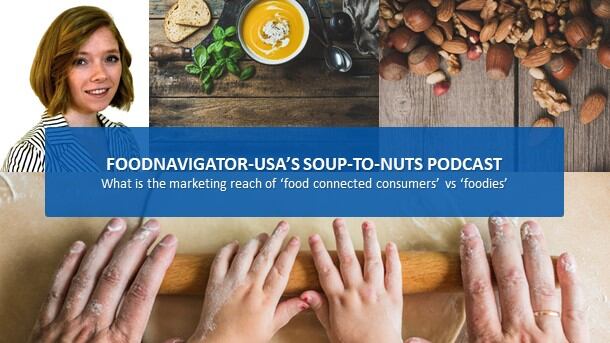A study sponsored by Fogelson & Co and conducted by Jump Rope Innovation released this month reveals that nearly two-thirds of Americans qualify as “food connected” and they account for a whopping $835 billion of US food expenditures. This is substantially more than those who are considered ‘foodies.’
Add on that food connected consumers tend to take a more open-minded approach to what they eat and the brands they buy, and it becomes clear that companies would be well served to expand or adjust their marketing to include this broader set of potential consumers, according to Susie Fogelson, the founder and CEO of F&Co. and the former head of branding and strategy at the Food Network.
In this episode of FoodNavigator-USA’s Soup-To-Nuts podcast, Fogelson explains the difference between food connected consumers and foodies and why brand marketers should care. She also breaks down strategies for reaching this “emerging, energized and passionate majority of mainstream Americans.”
Who are food connected consumers and how are they different from foodies?
According to the research sponsored by F&Co, food connected consumers are everywhere and are not defined by socioeconomic level, region or age. And, while they are a growing majority, Fogelson said they are notably different from the general population and from foodies.
“This term ‘foodie’ has really got a lot of baggage and is somewhat outdated,” she explained. “I think when people used to use the word foodie, and even to a certain extent now, foodie is a sort of exclusive gourmand group of hyper-passionate food people. … But that doesn’t really tell the whole story of what is happening in food.”
Rather, she said, a much larger group identified in the study as food connected consumers give more context to the broader food story. She explained that this group is defined by “pretty straight forward criteria of having some average or above average passion … around food and cooking or recipes, and they also care about where their food comes from.”
In general, she said, this group makes up about 62% of the US and of them only 24% are “super food connected,” or ‘foodies.’
“What we found in the study is that this is a very large and influential group. They are really from all kinds of demographics and regions and income. They are kind of everybody,” she said.
Food connected consumers believe in everything in moderation
What this means for brands is this group represents a much larger marketing base of influencers than previously thought, and with slight adjustments to their outreach efforts they could have a significantly larger impact, Fogelson said.
For example, foodies often divide themselves into food tribes and follow specific diets, such as keto or paleo. Or they look to maximize nutrients of value, such as protein, while avoiding others, such as sugar.
Food Centered Consumers, on the other hand, are much more likely to embrace everything in moderation – opening the door to a wider variety of products.
That said, they also want products that help them find life balance, and therefore prize convenience and products that are personalized for their experience, Fogelson added.
What do food connected consumers value?
While food connected consumers may be more open to trying a variety of products, the research also revealed they have higher standards of quality than mainstream American shoppers, and they are more likely to buy products based on their values.
Specifically, the study found 72% of respondents support causes they believe in and 50% say they try to buy brands that align with their values. And while Fogelson points out this is good for companies that are focused on social responsibility initiatives, she also notes that some may be surprised by which values topped participants’ lists – and which ones didn’t.
For example, food connected consumers place more import on addressing hunger and obesity than on whether a product is non-GMO. They also are looking for products that offer solutions to food waste.
Food connected consumers enjoy exploring cuisines
While food connected consumers take what is in their food seriously and care deeply about what brands’ values, they also approach cooking and eating as fun experience and chance for exploration.
For example, the study found two-thirds of food connected consumers consider themselves food explorers and 63% say they love to travel. In addition, they like to recreate at home the dishes they taste abroad. This plays out among the 81% of food connected consumers who say they cook from scratch frequently or most of the time and the 75% who say they often change recipes to reflect their liking.
With this in mind, Fogelson suggests one way brands can tap into this interest is by transparently sharing the stories behind their products and how they are sourced and made.
What is the best way to reach them?
How food connected consumers find ideas for recipes and products to buy is almost as diverse as their tastes – representing multiple gateways for brands to connect with them.
According to the survey, 91% of food connected consumers look for recipes online, but 56% also regularly watch food shows, 30% read food magazines and 20% follow bloggers and other food experts online.
Despite the differences across these platforms, Fogelson says a key factor for reaching food connected consumers across media is incorporating experiential marketing.
Building on this idea, Fogelson also encourages brands and retailers to work together to better engage food connected consumers where they shop – which according to the study is primarily at traditional grocery stores, farmers markets and specialty shops.
Ultimately, Fogelson said the main takeaway from the study is that brands who target not just foodies but the more diverse food connected consumer have more opportunities to sell their products and earn consumer loyalty – but to do so they will need to employ a mix of marketing strategies that touch on a variety of values.




